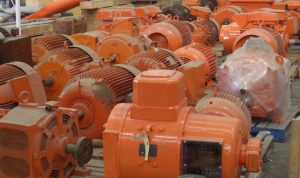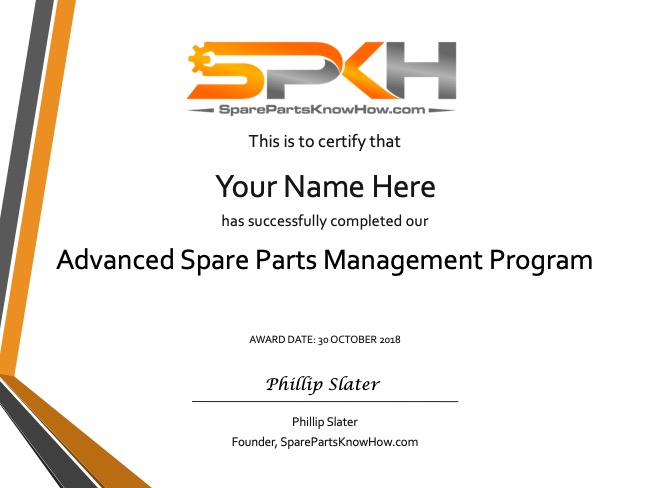Subject Area: spare parts inventory bias
 Recently, in a series of unconnected conversations, I was struck by how each speaker focused on some specific aspect of spare parts management that, to them, indicated how well (or poorly) they were doing in this area.
Recently, in a series of unconnected conversations, I was struck by how each speaker focused on some specific aspect of spare parts management that, to them, indicated how well (or poorly) they were doing in this area.
For example, viewing a single event (such as a stock out) as being representative of their entire inventory – “it’s all a mess”.
Or being super confident in their process/skills when it was clear, to me at least, that they should be doing something different – “we apply formula X”.
Another example: not seeing the range of options that were open to them and only considering what’s been done in the past – “here’s the way we handle this”.
This got me thinking about the biases that we can bring to our spare parts inventory, the effect of these on how much inventory is held, and how well it serves its purpose.
(pardon the pun)
Spare parts management requires the identification of need, determining requirements, procurement, storage, planning use, distribution (issuance), and installation. Eventually there may be obsolescence and disposal.
It is because of all these moving parts (there’s that pun again) that it is easy for people (and it is people, not companies) to take short cuts in their thinking. (Something the boffins might call heuristics.) This is a way to simplify the problems and avoid cognitive overload (or thinking too much).
This is how many biases work their way into the system.
For example, it is easy to ignore the potential for obsolescence by focusing only on the short term. The here and now. This might be called a ‘Myopic short-term aversion bias’.
How about when a benchmarking number is used as a reason to not take any further action because, ‘we are near the benchmark’. As a result, many genuine opportunities may be left unrealized. Let’s call that an ‘Anchoring bias’.
Here are some more:
A confirmation bias, when (say) a lack of stock outs is seen as proof (confirmation) that all is well with the inventory management processes.
A recency bias, when people make decisions based on the information that is most readily available to them rather than working to collect the information they really need.
One of my favourites: a Groupthink bias, when people conform to the opinions of the group, rather than thinking independently to make decisions.
And finally, the hidden bias otherwise known as the Implicit bias. This is when internalized stereotypes unconsciously affect actions and decisions. (When consulting, I think of these as the myths of the business; things that everyone ‘knows’ but no one talks about.)
If left unchecked, each of these biases can have a negative impact on your spare parts inventory.
 In the context of spare parts management, these biases can lead to overstocking of parts, the understocking of parts, extended downtime, and excessive obsolescence.
In the context of spare parts management, these biases can lead to overstocking of parts, the understocking of parts, extended downtime, and excessive obsolescence.
Here are some examples of spare parts inventory bias.
Maybe the bias leads to the over-reliance on historical data to predict future demand. This can result in the understocking of parts that are in high demand but have not been historically used frequently. Or the overstocking of parts that had a ‘demand spurt’ due to reason other than actual need, such as the human tendency to hoard parts in ‘squirrel’ stores.
Maybe there is an over-reliance on supplier recommendations for parts. This can result in the procurement of parts that are not really needed just yet. Anyone examined their supplier’s recommendation for a ‘two-year spares package’?
Or how about the over-reliance on the opinions of a small group of experts sometimes being a way to absolve others, more directly tasked with spares management, with any actual responsibility for outcomes.
Conversely, it may lead to the under-representation or even exclusion of certain groups in the decision-making process, like when maintenance want to set holding levels with little or no input from procurement.
These biases lead to all the negative outcomes that we seek to avoid with spare parts inventory management: overstocking – which requires unnecessary purchasing (and so costs), understocking – leading to downtime (and so costs), excessive obsolescence, expediting delivery, wasted labor, unnecessary overtime, distractions of management time and attention. Cost. Cost. Cost. Cost. And cost.
Be aware of your potential spare parts inventory bias and when you may be falling into the ease of a cognitive short cut rather than thinking through the actual needs for the future. When you recognize that happening you need to seek out a more appropriate course of action whether that is training, software, or just looking at the issue from a new perspective.
100% online
Study at a pace and place that suits you
Study at a pace and place that suits you
 The Advanced Spare Parts Management Course covers all the issues faced during the spare parts inventory management lifecycle.
The Advanced Spare Parts Management Course covers all the issues faced during the spare parts inventory management lifecycle.
Completing this course equips you with the know-how and skills to effectively manage all aspects of spare parts inventory.
The course specifically focusses on MRO and spare parts that are held in support of equipment operations and maintenance.
Posted by Phillip Slater